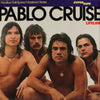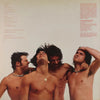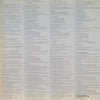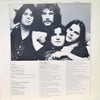









Pablo Cruise – Lifeline (Half-speed Mastering, unsealed)
RARITY – Unsealed - (Good conditions close to Mint)
Guitars, harmonica, vocals, bass on "Who Knows" - David Jenkins
Percussion, drums - Steve Price
Bass, vocals - Bud Cockrell
Piano, keyboards, synthesizer, backing vocals - Cory Lerios
Saxophone - Geoffrey Palmer, Steve Frediani
Electric guitar, backing vocals, tambourine on "Lifeline" - Andrew Gold
Backing vocals - Don Francisco, Venetta Fields
Guitar harmonies on "Zero to Sixty in Five" - Dan Levitt
Pedal steel guitar on "Look to the Sky" - Dan Dugmore
Strings and horn arrangements on "Zero to Sixty in Five" - David Campbell
Written by David Jenkins (A1, A4, B1, B5), Cory Lerios (A1, A4, B1, B5), Ron Nagle (A2, A5), Eugene Autry (A3), John Blakely (A5), Bud Cockrell (B2, B4), David Jenkins (B3, B5), Stephen Price (B5)
1 LP, Gatefold jacket
Original analog Master Tape : YES
Half-speed mastered
Heavy Press : 180g Super Disc
Record Color : Black
Speed : 33 RPM
Size : 12’’
Stereo
Studio
Record Press : unspecified
Label : Nautilus Recordings
Original Label : A&M Records
Recorded at Sound Factory, Hollywood
Engineered and produced by Val Garay
Mastered by Darrell Johnson
Photography by Norman Seeff
Art direction by Roland Young
Originally released March 1976
Reissued in 1979
Tracks:
Side A:
1. Crystal
2. Don't Believe It
3. Tearin' Down My Mind
4. (I Think) It's Finally Over
5. Lifeline
Side B:
1. Zero To Sixty In Five
2. Look To The Sky
3. Never See That Girl Enough
4. Who Knows
5. Good Ship Pablo Cruise
Reviews:
Lifeline is the second album by the California soft rock group Pablo Cruise. Released in 1976, the album reached No. 139 on the Billboard Top LPs chart in the United States. In 1977, Barbra Streisand recorded "Don't Believe It" with mostly different lyrics for her album Superman
Half-speed mastering
In half-speed mastering, the whole mastering process is slowed down to half of the original speed. A typical 33 1/3 rpm record is cut at 16 2/3 rpm. The source material is also slowed down (reducing the pitch in the process) meaning the final record will still sound normal when played back. Slowing the whole process down allows more time, which means the end result sounds better and is more efficient — allowing engineering to minimize the effects of inherent limitations within the vinyl format. The result is a more accurate and more open high-frequency response in the half speed vinyl when compared with a normal speed recording.
Ratings :
AllMusic : 3 / 5 ; Discogs : 3.65 / 5



